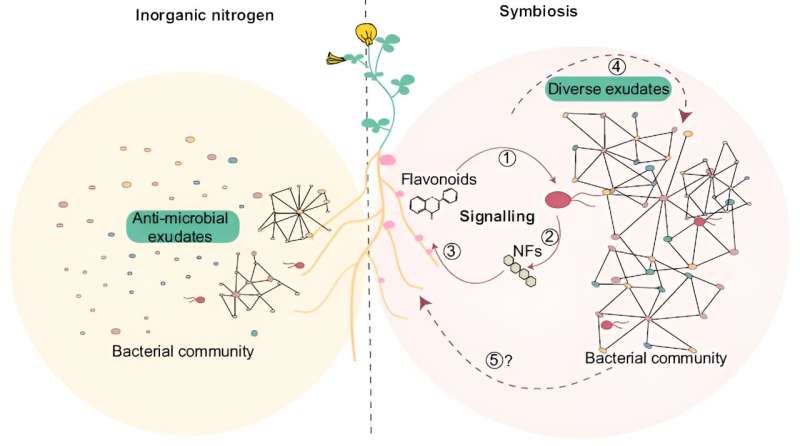This article has been reviewed according to Science X's editorial process and policies. Editors have highlighted the following attributes while ensuring the content's credibility:
fact-checked
peer-reviewed publication
trusted source
proofread
Study reveals key role of plant-bacteria communication for assembly of a healthy plant microbiome

In an interdisciplinary study, researchers have discovered that symbiotic bacteria communicate with legume plants through specific molecules and that this communication influences which bacteria grow near the plant roots. The findings provide insights into how plants and soil bacteria form beneficial partnerships for nutrient uptake and resilience. These results are a step towards understanding how communication between plants and soil bacteria can lead to specific beneficial associations providing plants with nutrients.
The results in Nature Communications find that symbiotic, nitrogen-fixing bacteria can ensure dominance among soil microbes due to their signaling-based communication with the legume plant host. Researchers discovered that when legumes need nitrogen, they will send out from the roots and into the soil specific molecules that are in turn recognized by the symbiotic bacteria to produce another molecule, the Nod factor, which is recognized reciprocally by the legume plant.
When this mutual recognition is established, the plant will modify the panel of root secreted molecules and in this way will affect the soil in which bacteria can grow in the vicinity of their roots.
Plants like legumes have a special relationship with certain bacteria in the soil. These bacteria help the plants grow in soil that does not have much nitrogen by converting nitrogen from the air into a usable form. Depending on the nitrogen available in the soil, legume plants can be in different states: lacking nitrogen, in a partnership with the bacteria, or using nitrogen from inorganic sources like nitrate.
The symbiosis with nitrogen-fixing bacteria was shown before to affect the rest of microorganisms living around the plant roots. However, it is not always clear how this partnership affects other microbes, and whether it depends on how much nitrogen the plant has.
In the new study, the team found that the communities of bacteria around the roots and in the surrounding soil differ depending on and have predictive power of the plant's nitrogen status. Moreover, it was found that signaling exchange between legume and its symbiont plays a critical role in modulating the profile of root secreted molecules, influencing the assembly of a symbiotic root microbiome.
The results provide valuable insights into the complex interplay between nitrogen nutrition, Nod factor signaling, and root microbiome assembly. The findings emphasize the importance of symbiosis and nitrogen nutrition in shaping plant-bacteria interactions, offering potential applications in agriculture and sustainable plant growth.
This is a clear example of interdisciplinary research, where different types of expertise in chemistry from Aarhus University's Associate Prof. Dr. Marianne Glasius to analyze root exudates, in mathematics from Prof. Dr. Rasmus Waagepetersen to develop predictive models, and in plant genetics and microbiome from Prof. Dr. Simona Radutoiu have enabled complex causational studies of root-associated bacterial communities.
By integrating these diverse fields, the researchers were able to answer key questions about how nitrogen nutrition and symbiosis influence plant-bacteria interactions, providing valuable insights into sustainable agriculture.
More information: Ke Tao et al, Nitrogen and Nod factor signaling determine Lotus japonicus root exudate composition and bacterial assembly, Nature Communications (2024). DOI: 10.1038/s41467-024-47752-0
Journal information: Nature Communications
Provided by Aarhus University




















